Keywords
Hypoglycemic, Hypolipidemic, Sweet potato, Wistar Albino rats
Introduction
Diabetes mellitus is a metabolic disorder affecting carbohydrate, fat and protein metabolism. It affects nearly 10% of the population worldwide [1]. Thus represent a heterogeneous group of disorder with hyperglycemia which is due to impaired glucose utilization resulting from defective or deficient insulin secretory responses, along with hyperglycemia abnormalities in serum lipids [2-5]. Diabetes is associated with micro vascular and macrovascular complication which are the major causes of morbidity and death in diabetic subject [6,7].
Hypoglycemia is a common, potentially avoidable consequence of diabetes treatment and is a major barrier to initiating or intensifying anti-hyperglycemic therapy in efforts to achieve better glycemic control [8]. Therapy regimen and a history of hypoglycemia are the most important predictors of future events. Other risk factors include renal insufficiency, older age and history of hypoglycemia associated autonomic failure [9].
Reported rates of hypoglycemia vary considerably among studies because of differences in study design, definitions used and population included among other factors [10]. Although it occurs more frequently in type 1 diabetes, hypoglycemia also is chronically important in type 2 diabetes. Symptoms experienced by patient vary among individuals and many events remain undiagnosed [11,12].
The incidence of sever events is unevenly distributed with only a small proportion (5%) of individuals according for>50% of events. Consequently, clinician must be conscientious in obtaining thorough patient histories because an accurate picture of the frequency and severity of hypoglycemic events is essential for optimal diabetes management [13-15].
Severe hypoglycemia in particular is associated with an increased risk of mortality, impairment in cognitive function and adverse effect on patient quality of life [16].
Dyslipidemia is a known risk factor for cardiovascular disease, a common cause of morbidity and mortality even in developing countries [17]. The drug used to modulate lipid level in serum often has deterious side effect [18].
A great number of medicinal plants have been used in the treatment of diabetes in different parts of the world. Some of which are without scientific scrutiny; the world health organization has also encouraged and recommended the use of plants as an alternative therapy for diabetes especially in countries where access to the conventional treatment of diabetes is not adequate [19-21].
Sweet potatoes (Ipomea batatas) are excellent sources of plant proteins with very low calories. Unlike other starchy root vegetables, it is used in folk medicine for the treatment of metabolic diseases [22]. Its leaves, the by-products possess activities of accelerating metabolism, preventing atherosclerosis, protecting eyesight, hypoglycaemia and antioxidant [23].
Ipomea batatas is used for the treatment of diabetes although its mechanism of action is enigmatic. The present study was therefore intended to investigate the antidiabetic activity of Ipomea batatas extract and its effect on hepatic enzymes in alloxan induced diabetic rat [24].
Several reports have indicated that the phytochemicals in sweet potato possess multifaceted actions including antioxidant, anti-mutagenic, anti-inflammatory, antimicrobial and anti-carcinogenesis and thus are important for several health promoting functions in humans [25]. This present study is designed to determine the hypoglycemic and hypolipidemic potentials of sweet potato on a Wistar albino rat [26].
Materials and Methods
Collection and Identification of Sweet Potato
The sweet potato where purchased from Umuahia main market at Obani and was identified by Dr. Omodamiro RM. After the identification, they were pilled and sliced and then air dried to a constant weight under the sun shield environment and was later milled to a powdered form.
Extraction of Ipomoea batatas (Sweet Potato)
100 g of milled sweet potato where mixed with 400 ml of methanol in a Bama bottle and shake in every 30 minutes for 3 days and extracted on the 3rd day. During the extraction; the filtrate was poured into the beaker to heat using the water and the bath solute was discarded. The solvent was evaporated to dryness leaving the sweet potato on the bottom of the beaker.
Animal Housing and Handling
Eighteen adult-female albino rats of (8-10 weeks of age) were purchased from University of Nigeria Nsukka. They were housed in stainless steel cages in the animal house of the Department of Biochemistry of Michael Okpara University of Agriculture Umudike, under-humid condition and allowed free access to Food (Vital Grower’s Mesh) and clean tap water and were acclimatized for two weeks.
Experimental Design
The extracted Ipomoea batatas was dissolved in water and was administered to the animal according to their body weight. The glucose level of the rat was taken in each of the group on the first day before administration.
The Group 2 was administered 5 mg/kg of the standard drug (Glibenachmide)
The Group 3 was administered 1000 mg/kg of the extract.
The Group 4 was administered 750 mg/kg of the extract.
The Group 5 was administered 500 mg/kg of the extract.
The Group 6 was administered 250 mg/kg of the extract.
The administration process were carried out for 7 days and the in glucose level was recorded in every 2 days of administration for that 7 days of administration, one hour after taken the meal glucose level in taken using a digital glucometer (Accu-Check Active).
Determination of Serum Total Cholesterol
Serum total cholesterol concentration was determined using the method of as contained in QCA commercial kit. Three (3) test tubes were set up in a test tube rack and labeled blank (BL), standard (ST) and sample (SA) respectively to the blank was added (10 μl) of distilled water, 10 μl standard specimen to the standard test tube and 10μl sample (serum) to the sample test tube. To each of these test tubes was added 100 μl of the cholesterol reagent. It was thoroughly mixed and incubated for 10 minutes at room temperature (RT) (20-25°C). The absorbance of the sample (A sample) against the blank was taken within 60 minutes at 500 nm.
Calculation:
The total cholesterol concentration in the simple was calculated using the general formula:

Determination of Serum triacylglycerol concentration
Serum triacylglycerol concentration was determined using the method of Albers et al. (1978) as contained in randox commercial KIT. A quality 0.1 ml of the sample was pipette into a clean tube labeled tube and 1.0 ml of trichloroacetic acid (TCA) was added to it, mixed and then centrifuged at 250 rpm for 10 minutes the supernatant was decanted and reserved for use. The assay procedure was carried out.
Calculation:
The concentration of triacylglycerol in serum was calculated as follows:

Determination of Serum High Density Lipoprotein- Cholesterol Concentration
Serum HDL – cholesterol concentration was determined using the method of Albers et al., (1978) as contained in QCA commercial kits. The precipitant solution 0.1 ml was added to 0.5 ml of the serum sample and mixed thoroughly and allowed to stand for 15 min at room temperature (20-25°C); then centrifuge at 2,000 X g for 15 minutes. The cholesterol concentration in the supernatant was determined.
Calculations:
The HDL-cholesterol concentration in the sample was calculated using the following general formula:

Results and Interpretation
The results were analysed for mean significant difference using ANOVA (SPSS version 22.0) and accepted at p<0.05.
The figure below shows that the control group (98.86 ± 12.60) is non-significantly (p>0.05) higher when compared with 750 mg/kg (92.62 ± 11.82) groups, and non-significantly (p>0.05) lower when compared with 1000 mg/kg (104.49 ± 1.46), 500 mg/kg (105.83 ± 10.41) and 250 mg/kg (102.77 ± 6.57) groups (Figure 1).
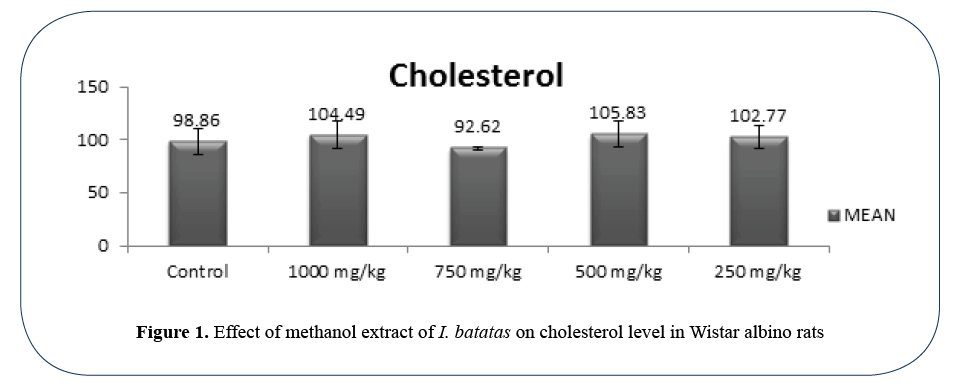
Figure 1: Effect of methanol extract of I. batatas on cholesterol level in Wistar albino rats
The result in Figure 2 above shows a non-significant (p>0.05) increase in the control group (155.49 ± 9.15) when compared with the extract – treated groups. The 500 mg/kg and 250 mg/kg groups are significantly (p<0.05) higher than the 750 mg/kg and 100 mg/kg groups.
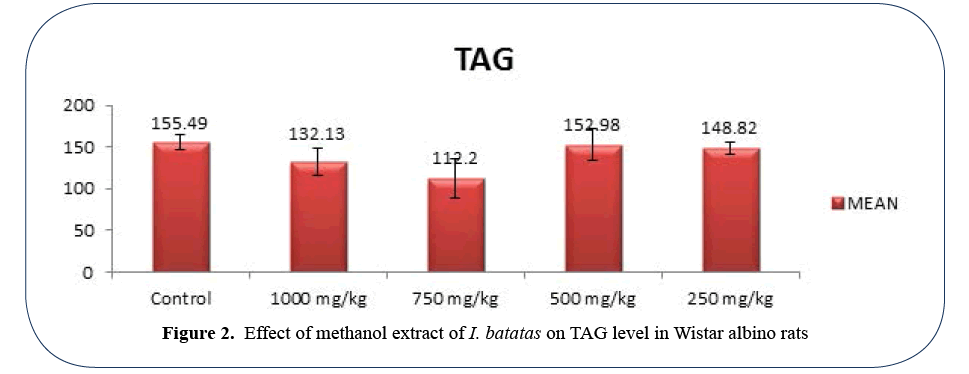
Figure 2: Effect of methanol extract of I. batatas on TAG level in Wistar albino rats
From the result below, the control group (52.84 ± 2.10) shows no significant (p>0.05) increase in HDL when compared with the other extract-treated groups. The extract – treated groups show a significant (p<0.05) increase (Figure 3).
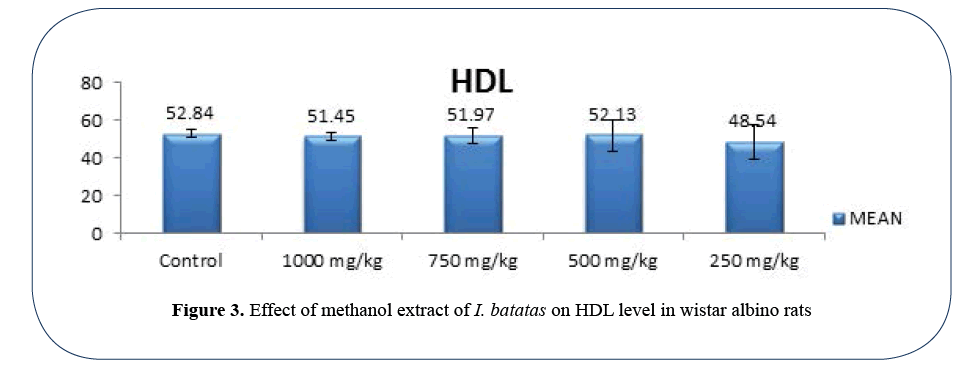
Figure 3: Effect of methanol extract of I. batatas on HDL level in wistar albino rats
From the chart below (Figure 4), there is a non-significant (p>0.05) increase in LDL of the control group when compared with the extract-treated groups.

Figure 4: Effect of methanol extract of I. batatas on LDL level in wistar albino rats
The result in Figure 5 and 6 below shows a significant (p<0.05) decrease in the control (24.92 ± 1.33) when compared with 1000 mg/kg extract-treated group (36.62 ± 2.81). It (control) also showed a significant (p<0.05) increase when compared with the 750 mg/kg extracttreated group (18.20 ± 2.74).
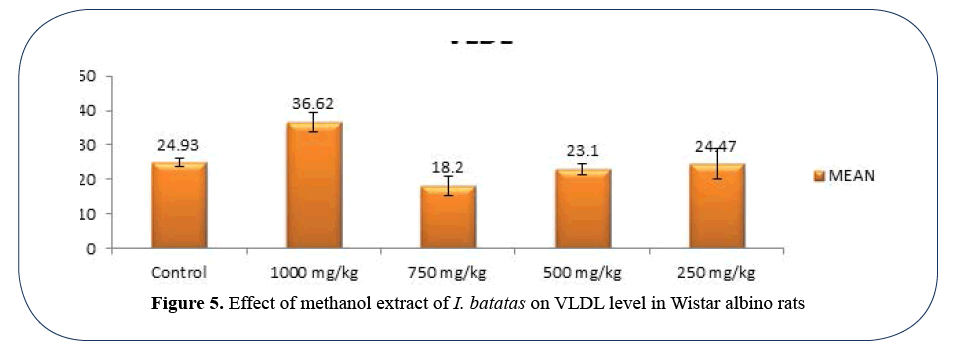
Figure 5: Effect of methanol extract of I. batatas on VLDL level in Wistar albino rats
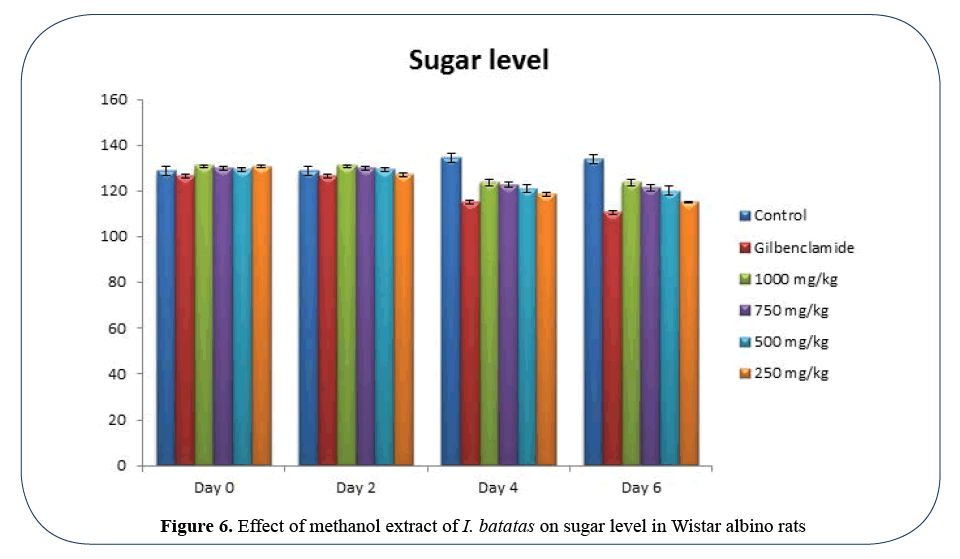
Figure 6: Effect of methanol extract of I. batatas on sugar level in Wistar albino rats
Discussion
Assessment of plasma lipid profile is required for the state of wellbeing of every individual as cardiovascular diseases and coronary heart diseases are silent, serial killers of our age [27,28]. The assessment of plasma haematological parameters can be used to determine how toxic a com pound can be to the blood parameters. Some Phytochemicals may have deleterious effects on the blood cells and to this end, it was necessary to determine the effect of the leaf extracts of I. batatas on serum lipid profile [29].
The dose sensitive increase in the concentration of HDL- cholesterol and reduction of the very low density lipoproteins cholesterol of the experiment showed that in the right dose, I. batatas can be used to treat cardiovascular diseases and coronary heart diseases, justifying its use in folk medicine for the treatment of cardiovascular diseases30. Added to it, this is the presence of flavonoids and other poly phenolic compounds which have the ability to scavenge for free radicals, therefore acting as antioxidants [31-33]. It has been established that free radicals help prevent cardiovascular diseases by interfering with the oxidation of the very low density lipoproteins and low density lipoproteins, which are the chief engineers of atherosclerosis. The increase in the concentration of triacylglycerol during the course of the study indicated that the plant had the ability to increase the rate of lipid breakdown; lipolysis, leading to the accumulation of TAG’s. To this end it is justified why the plant is used as tonic in traditional medicine, since it facilitates the use of fatty acids as main energy source [34-37].
This increase in the rate of lipid breakdown may also have been responsible for the increase in the concentration of total cholesterol [38-40] because the breakdown of fatty acids via the beta oxidation pathway yields acetyl COA, which condenses to HMG coA (β- Hydroxy β-methyl glutaryl coenzyme A), then is reduced to Mevalonate by HMG COA reductase, the committed step in cholesterol biosynthesis [40-42].
From my results, there was a significant decrease in serum glucose concentration of diabetic animals treated with Ipomoea batatas extract compared to the normal control group [43,44]. This observation supports the report of Nishikant et al. and Ijaola et al. The possible mechanism by which aqueous extract of Ipomoea batatas brings about its hypoglycaemic action may be, by potentiating the insulin effect, either by increasing the pancreatic secretion of insulin from the cells of islets of Langerhan’s or its release from bound insulin, thereby, decreasing the postprandial glucose in animals. This may be the cause of the increased body weight in Ipomoea batatas extract treated rats [45,46].
Conclusion and Recommendation
From this work, it is seen that the methanol extract of I. batatas significantly reduced some lipid profile parameters responsible for atherosclerosis and sugar level as well. Thus, it is recommended that this plant be analysed in further studies so as to identify the phytochemical responsible for these activities.
References
- Anbuselvi S, Balamurugan T. Phytochemical and anti-nutrient constituents of cassava and sweet potato. World J Pharm Sci. 2014;3(3): 1440-1449.
- Anthoney S, Omwenga T. Analysis of photochemical composition of white and purple sweet potato (Ipomoea batata) root. Indian J Adu Plant Res. 2014.
- Austin P, Daniel F. The taxonomy, evolution and genetic diversity of sweet potatoes and related wild species. In: P Gregory (ed) Exploration, Maintenance and Utilization of Sweet Potato Genetic Resources. 1998.
- Berberich T, Takagi T, Miyazaki A, et al. Production of mouse adiponectin, an antidiabetic protein, in transgenic sweet potato plants. J Plant Physiol. 2005;162(10):1169-1176.
- Betterridge. Structural requirement for PCSK9 Mediated degradation of the low-density lipoprotein receptor. Proc Natl Acad Sci USA. 2008;105(35):13045-13050.
- Cryer PE, Axelrod L, Grossman AB, et al. Evaluation and Management of Adult Hypoglycemic Disorders: An Endocrine Society Clinical Practice Guideline. 2009;94(3):709-728.
- Dashti M, Kulik W, Hoek F, et al. A Phospholipidemic analysis of all defined human plasma lipoprotein. Sci Rep. 2011;1:139.
- Dashty M, Motazacker MM, levels J, et al. Proteoine of human plasma very low-density lipoprotein and low-density lipoprotein exhibits a link wah coagulation and lipid metabolism. Thromb Haemost. 2014;111(3):518-530.
- Dutta S. Sweet Potatoes for diabetes mellitus: A systematic review. Pharmacophore 2015;6(1):60-72.
- FAO. Production statistics for 1990 FAO, Rome, Italy. 1990
- Firedeinald WT, Levy RI, Friednickson DS. Estimation of concentration of low density lipoprotein cholesterol in plasma, without use of preparative ultra-centrifuge. Clin Chem. 1972;18(6):499-502.
- Gad L, George T. Evaluation and management of adult hypoglycemic disorders: An Endocrine society clinical practice guideline. J Clin Endocrinol Metab. 2009;94(3):709-728.
- Gropper J. “Sweet Potato” vegetable Brok: Forgotten natural remedies. SI: Lulu Coni. 2013.
- Gurmu F, Hussein S, Lanig M. The potential of orange fleshed sweet potato to prevent vitamin A deficiency in Africa. Int J Vitam Nutr Res. 2014;84(1-2):65-78.
- Hayase F, Kato H. Antioxidative Component of Sweet Potatoes. J Nutr Sci Vitaminol. 1984;30(1):37-46.
- Kusano S, Abe H. Antidiabetic activity of white skinned Sweet Potato (Ipomoea batatas L) in Obesezuker fatty rats. Biol Pharm Bull. 2000;23(1):23-26.
- Lila MA. Anthocyanins and human health: An in vitro investigation approach. J Biomed Biotechnol. 2004;2004(5): 306-313.
- Luduik B, Neuffer B, Pacina G. Efficacy of Ipomoea batatas (Caiapo) on diabetes control in type 2 diabetic subj treated with diet. Diabetes Care. 2004;27(2):436-440.
- Ludurk B, Hanefeld M, Pacini G. Improved metabolic control by Ipomoea batatas (Caiapo) is associated with increased and poneetin and decreased fibrinogen level in type 2 diabetic subjects Diabetes, Obesmetab. Diabetes Obes Metab. 2008;10(7):586-592.
- National Institute of Diabetes and Digestive and Kidney Diseases. Evaluation and management of adult hypoglycemic disorders. An Endocrine Society Clinical Practice Guideline. 2008.
- Ogunrinola OO, Fajana OO, Olaitan SN, et al. Anti-diabetic activity of Ipomoea batatas leaves extract effect on hepatic enzyme in alloxan-Induced diabetic rats. Res J Med Plant. 2015;9(5):227-233.
- Park SY, Lee SY, Yang JW, et al. Comparative analysis of photochemical and polar metabolite from coloured sweet potato (Ipomoea batatas L) tubers. Food Sci Biotechnil. 2016.
- Islam S. Nutritional and medicinal qualities of sweet potato top and leave. Cooperative Extension Service, University of Arkansas. 2014.
- Perkin RM. Pediatric hospital medicine: Text book of inpatient management. 2008
- Purseyloue JW. Tropical Crops: Dicotyledons-Longman Scientific and Technical New York: John Wiley and Sons. 1968
- Robbins RJ. Phenolic acids in foods: An overview of analytical methodology. J Agric Food Chem. 2003;51(10):2866-2887.
- Runnie L, Salleh MN, Mohammed S, et al. Relaxation Induced by common edible tropical plant extracts in isolated rat aolta and mesenteric vascular bed. J Ethnopharmacol. 2004;92(2-3):311-316.
- Scalbert A, Johnson IT, Sactmarsh M. Pooyphenols: Antioxidant and beyond. Am J Clin Nutr. 2005;81(1 Suppl):215S-217S.
- Schrier RW. The internal medicine Casebook real patient. 2007.
- Sidhu D, Naughler C. Fasting time and lipid levels in a community-based population: A cross-sectional study. Arch Intern Med. 2012;172(22):1707-1710.
- Sniderman AD, Blank D, Zakarian R, et al. Triacyl Slyceridosans small dense LDL: The twin Achilles heels of the friedewald formula. Clin Biochem. 2003;36(7):499-504.
- Spence JO. Chinese Roundabout Essays in History and Culture WW Norton & Company. 1993.
- Stephen KOH (1990) Tropical root and tuber crops. In: J Janick, JE Simon (eds) Advances in New Crops Relieved 26th July, 2017.
- Takekoshi Y. Economic Aspects of History of the Civilization of Japan North Carolina Sweet Potato Commission (NCSPC). 1930.
- Teoo CC, Truong VD, Mcfeeters RF, et al. Antioxidant activities, phenolic and ß-carotene contents of sweet potato genotypes with varying flesh colors. Food Chem. 2007;103(3):829-838.
- Toth P. The “Good Cholesterol” high density lipoprotein. Circulation 2005;111(5):e89-e91
- Toth PP. Cardiology patient page. The "good cholesterol": High-density lipoprotein. Circulation. 2005 Feb 8;111(5):e89-91.
- Undsay RS, Funahashi T, Hanson RL, et al. Adiponectin and development of type 2 diabetes in the Pinna Indian Population. Lancet. 2002;360(9326):57-58.
- New drugs in the management of diabetes mellitus In: Pickup JC, Williams G (eds) textbook of diabetes. Black well, Oxford. 1991;977-993.
- Woolfe JA. Sweet Potato: An untapped food resource. Cambridge University Press and the International Potato Center (CIP), Cambridge. 1992.
- Worlfe JA. Sweet potato an untapped food resource. The International Potato Center (CIP). 1992.
- Yanai HJ, Adachi H, Katsuyama H, et al. Causative antidiabetic drugs and the underlying clinical factors for hypodiabetic in Patients with diabetes. World J Diabetes. 2015;6(1):30-36.
- Zakir S, Sarwar M, Allen J, et al. Impact of sweet potato cultivars on blood glucose level in diabetic and healthy participants. Int J Agr Biol. 2008;10:316-320.
- Zentner E. Effect of phytogenic feed additives Quillaja saponaria on ammonia in fattening pigs. 2011
- Zhan DP, Ghislain M, Human Z, et al. Evaluation and Management of Adult Hypoglycemic Disorders: An Endocrine Society Clinical Practice Guideline. 1999
- Zhao R, Liq L, Li J, et al. Anti-diabetic activity of flavone from Ipomoea batatas leaf in non-insulin dependent diabetic rats. Int J Food Sci Technol. 2006;42(1):80-85.










